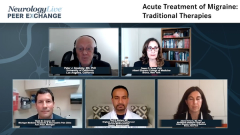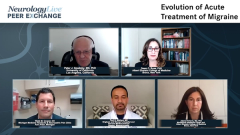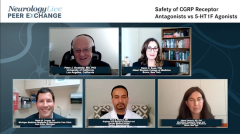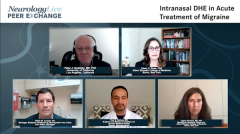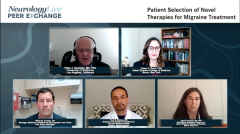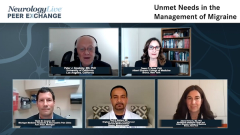
Use of 5-HT1F Agonists in Acute Treatment of Migraine
Episodes in this series

A review of the FDA approval of lasmiditan, a selective 5-HT1F receptor agonist, for the acute treatment of migraine.
Peter J. Goadsby, MD, PhD: As we move into talking about the new acute therapies, what I want to do is talk a bit about the new mechanisms of action. We’ve talked about specific migraine therapies, particularly triptans, which act at the serotonin 5-HT1B and 1D receptors. Some, like Naratriptan or Sumatriptan, act on the 1F receptor. Others, like Rizatriptan, for an example, don’t effectively act at the 1F receptor.
The 5-HT1F receptor is being pursued because it has a purely neural effect. We’re calling drugs that target the 5-HT1F receptor ditans. In contrast, the other group of new therapies, the gepants, are calcitonin gene-related peptide [CGRP] small-molecule receptor antagonists.
Two of them, which we are able to discuss, ubrogepant and rimegepant, have very distinct mechanisms of action. Jelena, the FDA approved the first of the ditans, or 5-HT1F agonists. That was late in 2019. Tell us a bit about how important it is to have a new FDA-approved ditan and how to use it.
Jelena Pavlovic, MD, PhD: Thank you, Peter. As we were saying, triptans have the challenge of binding to 5-HT1B and blood vessels, and therefore causing vasoconstriction. Lasmiditan is unique in the sense that it is highly selective to the 5-HT1F receptor. It’s the antagonist of 5-HT1F, and it has much higher selectivity for that receptor than the triptans have for the 5-HT1B and 1D. Therefore, it has no vasoconstriction properties, which have been the primary challenge with triptans.
5-HT1 receptors are present at multiple locations in the trigeminal vascular system, but they’re not on the blood vessels. It likely works at the level of the trigeminal ganglion, trigeminal nucleus caudalis, cerebral vessels, neocortex, and hippocampus. It has multiple modalities in the pain activation of migraine. There were multiple studies, especially the SPARTAN study, that chose 3 doses—50, 100, and 200 mg—where 1 dose of lasmiditan could improve pain and most bothersome pain symptoms in 2 hours.
A portion of patients actually became pain-free within 2 hours. Overall, across 2 clinical trials with these 3 doses, there were 28% to 39% of patients who achieved complete elimination of migraine pain at 2 hours, compared with 15% and 21% with placebo. The challenge with lasmiditan, though it is not a vasoconstrictive, is that given its CNS [central nervous system] penetration, it does have CNS adverse effects. Those primarily manifest as dizziness, feeling tired, paresthesia, and cognitive impairment.
The FDA required additional studies for lasmiditan for this reason, including a study showing potential for addiction. They finally awarded a controlled substance Schedule V rating to lasmiditan, so it is a controlled substance at this point. There is an 8-hour driving restriction, given the cognitive impairment seen after dosing. The recommendation is not to drive for 8 hours or operate heavy machinery. Though some may find this very limiting, in terms of their prescribing, what does the migraine patient do when they have a really bad attack?
They go home, go to bed, and want to sleep. Generally, they’re not setting off on a 3-hour driving trip. Though this is somewhat limiting, and we obviously have to emphasize this to patients, in my practice I typically find that patients don’t find it limiting if it works for them. If this is a medication that provides relief, they will take it in the evening after they go home and are able to relax and recuperate following their migraine attack.
Peter J. Goadsby, MD, PhD: It’s an extraordinary development to be able to have selectivity over the 1B and 1D of 500-fold. We’ve all had people in our practices over the years who we felt a bit wobbly about putting on a triptan because of the 1B effect. All of a sudden, it is remarkable to find an era when that problem just went away. Nothing is perfect, as you outlined, but it’s hard not to think of that as an advantage. In clinical practice, that’s certainly the case.
Wade M. Cooper, DO: Let me just add that 1 of the reasons I like lasmiditan in my practice is that it does have some ability to lower CGRP concentration in the periphery. There is a peripheral anti-CGRP effect. The effect is not strong, but it’s 1 of the few FDA-approved medicines for migraine that goes centrally. That’s what defines it and separates it from some of the other agents out there.
That central function allows you a 4-hour same efficacy of treatment. If someone has to delay 4 hours, they still do really well with this medicine. But you pay a price for the central action, and that’s the adverse-effect profile, which was already mentioned.
Peter J. Goadsby, MD, PhD: Yes, that’s a very good point.
Newsletter
Keep your finger on the pulse of neurology—subscribe to NeurologyLive for expert interviews, new data, and breakthrough treatment updates.

